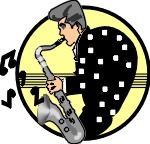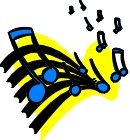This Online Lesson is (c)
, Ryan Fraser. All right reserved. NO COMMERCIAL DISTRIBUTION.
When you are just starting out, the best favour that you can possibly do for yourself is to spend a
bit of money to make sure that you have the best quality equipment that you can find. But this
DOESN'T mean you have to spend a whole lot of money to buy a really super-duper expensive
saxophone.
So where should you be spending your money? Simple - at the place which makes the most
difference in your playing - the mouthpiece. I'll talk about what to look for in terms of
saxophones in a minute, but lets start by talking about why getting a good mouthpiece is so much
more important than getting a good saxophone.
Why get a good mouthpiece first?
If you think about it for a moment, it makes sense to get a good mouthpiece. After all, the
mouthpiece is the part of the saxophone that generates the sound. If you don't have a good
mouthpiece, you won't make a sound, even on a $6000 top of the line professional saxophone. If
you do have a good mouthpiece, you can start off on the right foot (so to speak - try not to put
yours in your mouth!). My usual recommendation is to purchase a Selmer C* mouthpiece, or
perhaps a Yamaha Custom Mouthpiece (4C or 5C). These mouthpieces are what the pros use -
and they are relatively inexpensive. A brand new Selmer or Yamaha Custom mouthpiece will set
you back around $100 (Canadian) for an Alto model, or about $150 for a Tenor mouthpiece. The
standard student mouthpieces which companies ship with student model instruments cost about
$20-40. That's not a huge increase in price for the increase in quality that you will get by
upgrading. (These are "classical" mouthpieces - but I recommend them even for wannabe jazz
players to begin with. Jazz mouthpieces can be harder to control. Build up your chops on these,
then move onto a good quality jazz mouthpiece, like a Meyer #5.)
The best part about spending that kind of money on the mouthpiece is that it will work just fine
for the rest of your life, provided that you take care of it properly. Better yet, you will always
have a consistent yardstick by which to measure different saxophones. Since the mouthpiece
stays the same each time you try a new horn, then presumably, any differences that you feel or
hear while playing are actually going to be the saxophone, not the mouthpiece. This can be very
important since a poor quality mouthpiece can make a very nice saxophone sound absolutely
horrible.
One more thing - even if you are not looking to buy a saxophone right now - say you are renting,
or borrowing from school, or a friend, there are many advantages to purchasing your own
mouthpiece. Right at the top of the list is the fact that you really don't want to catch anybody
else's cooties! Many diseases can be transmitted via saliva. Think about that next time you play
on someone else's instrument... So, by spending a few dollars now, you can sound a whole lot
better, as well as improve your health!
OK, Fine. But I really want a new Saxophone!
 |
So lets assume you have a mouthpiece you are happy with. Great. Now take it with you and go
test play some saxophones. Before I talk about what types of saxophones to look for, let me give
you a few things to remember when looking for a saxophone in general:
- ALWAYS test play the instrument, and NEVER buy an instrument you haven't seen nor played. You are
going to spend a lot of money - don't take ANY chances.
Just because it is a good model, it doens't mean that it is a good saxophone. You can't tell what
sort of condition it is in until you have checked it out.
- If you are purchasing a USED Saxophone ALWAYS check the serial number of the instrument with your
local police, even if you are buying from a reputable dealer. Possession of stolen property is a
serious offence in most places. All you have to do if you live in Canada, is call your local police
station--before you buy the instrument--and get them to check the serial number and they will
call back within a few minutes after checking a national database of stolen items. Remember, it
is your loss (and possibly fines and jail time) if the police come knocking at your door. Play it
safe!
- Look around. Sometimes you can talk the seller to a better price if the competition is
selling at a lower price.
- When in doubt, find a local pro, bring it to them, and get their assessment (especially for
used instruments.) We know the market better than you do as a beginner.
OK. Now, you want to go and buy a saxophone, you walk into the shop, and there are 15
different options to choose from. What should you do? Buy the best quality saxophone you can
afford. Here's the reason. If you buy a new student model, the resale price after a couple of
years will be between 50-75% of what you paid for the instrument. If you buy an intermediate
model instrument, you will likely be able to sell it for 85-110% of its original value after a couple
of years. If you buy a pro horn, it will actually APPRECIATE in value. (My Alto, for example, has increased about 60% over its pre-tax purchasing cost. That is about a 7.5% increase per year - WAY
better than what you could have made in a GIC over the same time period, given the low interest
rates of the last few years. If you can afford it, in the long run you can almost play for free if you
are a savvy consumer.
If you don't have a lot of cash handy, look into rent-to-own options. Most good stores will have
some sort of equitable system in place. Also, buying a good quality, well maintained used
instrument at any level will ensure that you get the most value for your dollar- often you can
resell later on at a much higher profit. (And we starving musicians all love profit...!)
What brands and types are good to buy?
Almost without exception, there are two major players in the North American saxophone market.
The big guns are Selmer and Yamaha. Yamaha in particular has made huge gains in the
market over the last few years.
Please note that the following are recommendations based entirely on my own experience. I
have not been paid to endorse any of the following products, nor am I related in any way to any
of the companies mentioned. Use this information at your own risk.
Good Student Models
- YAMAHA 23. Probably the most popular student model on the market today, with good
reason. It is a well design, reasonably priced horn. The only major weaknesses that I have found
are a) the Thumb Key is horrible from an ergonomic standpoint and b) the Tenor model suffers
from the occasional difficulty with the octave mechanism while playing a G with the octave
(thumb) key pressed. These are relatively minor concerns. The poor ergonomic design does
have some long term ramifications, as it takes a while to readjust your hand position if you get a
"properly" designed thumbkey on a new horn. (I'll post a lesson on thumb technique at a later
date.) Yamaha tells me that the next version of this saxophone will have a much better designed
thumb key.
- JUPITER Student Models. Generally, a well design, well tuned instrument. Not quite as
nice as the Yamaha (in my opinion) but fairly reliable.
Good Intermediate Models
- YAMAHA 52. Again, a terrific horn from Yamaha. While I don't particularly care for the
feel on this horn, the quality of the metal is superb (near professional) and it sounds fabulous. If
you aren't a particularly technical player, but want a rich, robust warm tone, then this is the horn
for you. Again, I have some qualms about the octave keys, but this is slightly better than the
model 23. For the price, this is a terrific buy.
- EVETTE. This series is, I believe, the Selmer intermediate line. Well designed. I haven't
seen any around for a while, so I can't really add much more than this at this time.
Good Professional Models
- SELMER SUPER ACTION 80 (SERIES II and III). These two models are the creme de
la creme of the professional saxophone world. The Series III has been recently released. While
the only series III horn I've tried has been the Soprano, I was very impressed. Finally, Selmer is
making a soprano which comes close to the ease of play which I find on my old Yamaha 62. I
personally play a Selmer Series II Alto. I don't know if the price difference at the retail level
justifies the III over the II, but the quality of Selmer horns are quite high. Try a few different
saxophones though, since there is some variation between individual instruments made by
Selmer - they are slightly less consistent from the Yamaha. Be careful - Selmer also sells a
"Selmer USA" model sax, which in my opinion is vastly inferior to the SA80 II series. (and
much cheaper as a result!)
- YAMAHA 875 (Custom) and 675. These two Yamaha models have really made a dent
into the professional market. (I play a Custom (875) Tenor.) As far as I know, the 675 line is
now only made in the Soprano model. Terrific horns, with great design. Yamaha's quality
control on these horns is simply amazing - you can pick up a pair of Custom models anywhere in
the world, and they will respond virtually identically. The silver horns in particular have a
terrific, rich & warm sound. Only personal preference and a lot of testing will help you decide
between the Selmer SA80 II or III and the Yamaha Custom.
- SELMER MARK VI (USED ONLY - NO LONGER IN PRODUCTION) The "legend"
of saxophone players everywhere, there is still a huge used market in Selmer Mark VI
saxophones, which began production in the 1950's and ended in the late 1970's.. There are some
*fantastic* sounding Mark VI's out there - and there are some pretty lousy ones as well. Shop
carefully! Be aware that the Mark VI name comes with a hefty increase in the price tag, even if
it is an inferior horn. Production standards at the time were not as rigorous as now, so there
really is a huge variation between every horn (even within a few serial numbers apart.) Also,
given the premium you pay, you have to really consider that it is less advanced technically than
the newer Super Action 80 II series horn, which sounds, in my opinion just as good if not better
than the Mark VI. The Series II has a much better feel to the key placement and action. If you
look around, you'll probably find a comparable Series II selling for a lower price than most Mark
VI's.
- YAMAHA 62 (USED ONLY - NO LONGER IN PRODUCTION) The Yamaha 62 was
Yamaha's first major try at breaking into the professional market. (There was a model 61, but
one rarely comes across them.) Some of the earlier horns had a very soft metal mix, and my
repair specialist tells me that they often need to be fixed. (The metal is like "butter" he said...)
This said, the Yamaha 62 soprano, in my opinion is vastly superior to anything Selmer or
yamaha has made since. I love mine - lots and lots and lots. It has a great feel, has a light easy
tone, and I have never had any problems with it, and the metal seems rather stable (Serial number
in the 5200's.)
A Final word about Certain Professional Models
There are a number of manufactures right now who are producing a lower-end professional
saxophone which retails for about 1/3 to 1/2 of the top of the line Selmer or Yamaha models.
Some of these manufacturers include Winston, Cannonball, USA Horn, and others. SOME of
these saxophones are really a terrific buy for the money. Others are not. In my experience,
MOST manufacturers at this price level have much poorer quality control than the "biggies". A
couple of years ago I test played three Alto Saxes from one of these manufacturers (with
successive serial numbers) and I found that the first one was absolutely superb. The second was
OK, but had some serious pitch problems, and the third suffered both mechanical and pitch
difficulties. Buyer beware! Test play these manufacture's instruments carefully. You can get a
great deal, if you make sure you check the instruments over very, very carefully.
In my experience, these manufacturers do not make their instruments as consistently as Yamaha
or Selmer. They also tend to market to Jazz players, so the general tone of the instrument is quite
bright.
Related Articles
Advanced lesson on Equipment.






